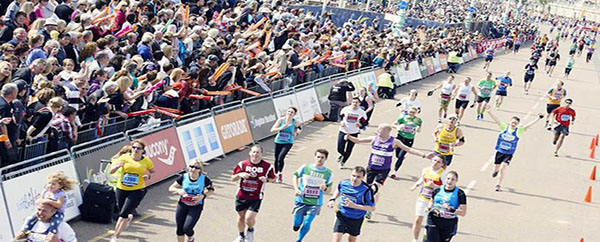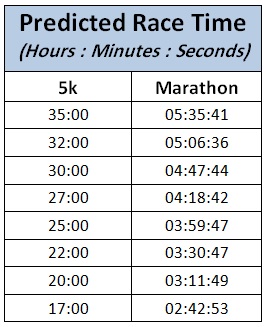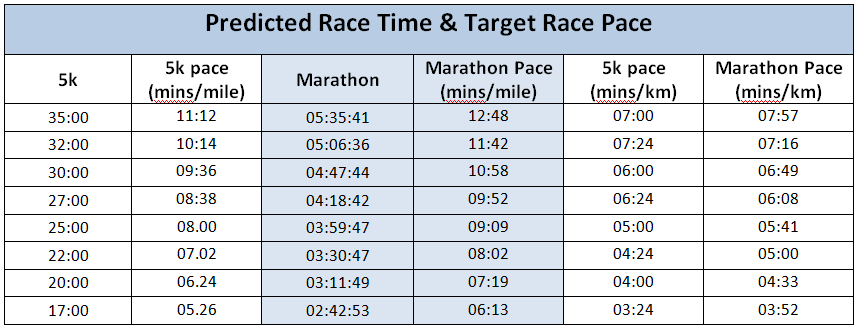A Look At Marathon Preparation

The most common mistake runners make when training for a marathon is incorrect pacing, often caused by not having a suitable target race pace or predicted race time. If your marathon plan is “I just want to finish” we recommend you pay particular attention to this article.
Why Is Pace Important?
Pace is a measure of how fast you are running, based on how many minutes it would take you at your current speed to complete a mile (or km if you are that way inclined). Most of us can run 100 metres in under 17 seconds, but maintaining that pace for one mile (i.e for 4 minutes and 41 seconds) would be another matter!
Eliud Kipchoge of Kenya can maintain it for just over twenty six miles, which is why he holds the current marathon world record of 2:01:39. Paula Radcliffe ran the 2003 London Marathon at a pace of 5 minutes 1 second per mile, setting a world record of 2:15:25 (with male pacemakers). Even if this is the first time you have ever run a marathon, it is vital that you know what pace your body will be able to run for 26.2 miles, otherwise you may find yourself running a fantastic first half and then grinding to a sudden halt.
Predicted Race Time
“I just want to finish” may have been enough to get you to sign up, but for most runners one of the best ways to avoid injury in training and have no nasty surprises on race day is to calculate your race day pace, i.e. the speed you plan to run the 26.2 miles. Unless you monitor your pace, you are highly likely to make the classic mistake of setting off way too fast (e.g. at your 5km parkrun pace) and then wondering why half way through your legs start feeling like lead.
Unless you are a highly experienced runner, you can rarely trust your instinct during a marathon. Your target race day pace will feel frustratingly slow for the first half of the race, but unless you stick to it you may well find yourself slowing down rapidly in the second half of the race and ‘hitting the wall’.
You can calculate your predicted race time by using one of fantastically simple online calculators. Runner’s World offer a free Race Time Predictor – all you have to do is enter a recent time for a particular distance, e.g. 5km parkrun, hit the button and bingo… you’ll now have predicted race times for half marathon, marathon, whatever distance you want (based on you putting the training in of course!).
If you haven’t done a parkrun yet (free, weekly, 5km timed runs all over the UK), I encourage you to do so as they provide a wonderful, fun opportunity for you to get used to running in a timed event and more importantly see how long it currently takes you to run 5km. This table shows predicted race times for a marathon based on common 5k times.

Target Race Pace
Now you know your predicted race time, you can use another online calculator to calculate your Target Race Day Pace. Try the Cool Running Pace Calculator here – just enter your predicted race time, the race distance and your target race pace will be calculated.
Below, I have expanded the original table so that it now includes 5km pace (in miles and km) and corresponding target race pace for a marathon (BM). As you can see, your target pace for a marathon is obviously slower than the pace you are able to run 5km.
This is very important as many new runners merrily set off at their 5km pace thinking that eventually they will be able to maintain that for 26.2 miles. It doesn’t happen that way. In fact, you may find you need to slow down during your long runs and save the faster pace for your tempo run or interval session during the week!

Building Your Training Plan
Armed with your predicted race time and target race pace, you are already far better prepared than a lot of other runners going into a marathon. You can now ensure that in those final few weeks to race day, your training sessions are designed to help you happily maintain your race pace for the full 26.2 miles.
- The Long Run
Getting the miles in is obviously a vital part of training for a marathon. Distance running relies on having a strong aerobic system; the greater your ‘aerobic capacity’, i.e. the ability of your body to use oxygen (also known as VO2max), the more energy can be created. However, many runners perform their long run way faster than their Estimated Race Pace. As a result, this are not preparing for race day and they are unnecessarily increasing risk of injury. - Mid Week Runs
Your mid week runs are where you now up the pace, taking your ‘tiredness level’ up to the 7’s and 8’s out of 10. Interval sessions, for example, in which you run your fastest possible half mile followed by a slower paced recovery mile, and repeat that combination a few times (depending on your level of fitness). Hill work provides another great midweek workout and can be a very effective way of building up neuromuscular fitness, i.e. the ability to keep your legs moving in an efficient manner even when fatigue sets in as you near the finish line on race day.
Warm Up, Cool Down, Conditioning
For most people, going straight into a challenging exercises session can shock the body and increase risk of injury. It therefore makes sense to ease yourself into your running session gently. Depending on your level of fitness & the type of training session you are going to do, this may just mean a brief walk or jog before you start running at your training pace for that particular day. If your training session is going to be more demanding, you may well want to spend longer warming up, include some brief speed intervals to get your body ready to exert itself at that intensity, or even the lunge matrix to help get your body ready for the demands. What is not generally necessary or helpful is spending time on static stretching (holding stretches for 15 seconds plus). You’re getting your body ready to move and use the range of motion needed for running, so why would we bother trying to touch our toes in a running warm up? Some studies show that static stretching may even reduce our running economy!
As far as the cool down goes, the same as the above applies, but in reverse. In other words, we don’t want to suddenly finish a hard workout and go immediately to not moving at all, or straight back to the stresses of life and work. The cool down should therefore incorporate a gentle return to normal heart rate whilst walking, or lying down and gently rotating & opening/closing joints. Again, there is little point to holding long static stretches in positions we have not even used during the run. There is no evidence that stretching can reduce running injury or reduce soreness following exercises, despite what many websites and professionals still recommend. Have a look at our H.E.L.P article on a suggested runners cool down routine.
Need Help?
If all of this has sounded a little bit daunting, don’t let it be. You are welcome to email us (matt@runchatlive.com or use the contact form ) any concerns you may have, and book an online consultation or face to face meeting in Brighton (if permitted). We can help you with any of the following:
- Creation of a training plan
- 1:1 or group strength conditioning
- 1:1 or group outdoor coaching
- Injury Treatment
- Rehabilitation
- Running Gait Analysis


0 Comments